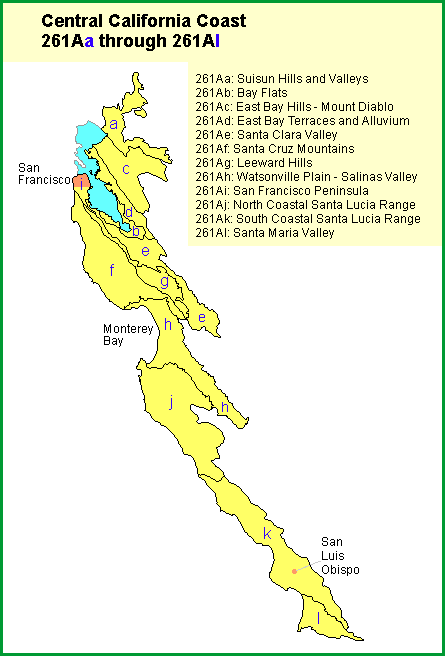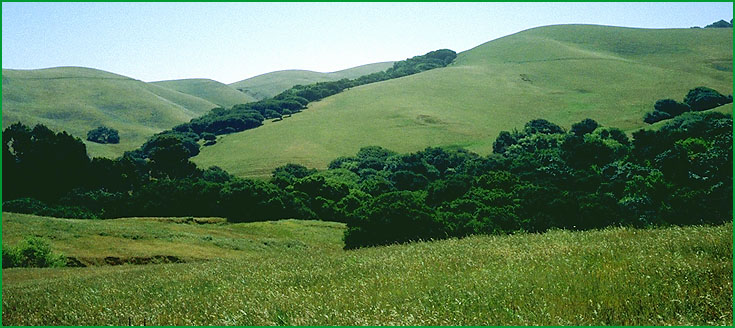 | Central California Coast and General Information |
from http://homepage.smc.edu/selby_william/california/chapter_1.html |
|
|
Subsection a, northeast of Vallejo Ś Charles B. Goudey |
from http://www.fs.fed.us/r5/projects/ecoregions/261a.htm
This section consists of mountains, hills, valleys, and plains in the southern Coast Ranges of California. It is close enough to the Pacific Ocean for the climate to be modified greatly by marine influence. The subsection is mostly in MLRA 14 and partly in MLRAs 4 and 15.
Geomorphology. Parallel ranges and valleys on folded, faulted and metamorphosed strata; rounded crests of subequal height. Coast Ranges geomorphic province.
Lithology. Cenozoic marine and nonmarine sedimentary rocks and alluvial deposits, and Mesozoic granitic and ultramafic rocks.
Soil Taxa. Alfisols, Entisols, Inceptisols, Mollisols, Ultisols and Vertisols in combination with isomesic, mesic or thermic soil temperature regimes and xeric, udic, ustic or aquic soil moisture regimes.
Vegetation. Predominant potential natural communities include the Blue oak series, Purple needlegrass series, Coast live oak series, Chamise series, Valley oak series, Redwood series, Douglas-fir - tanoak series and California sagebrush series.
The following series are found throughout the section and are not restricted to or extensive in any subsection. Series dominated by exotic plants are not listed under subsections unless they are extensive and stable.
Series dominated by exotic plants: Broom series, California annual grassland series, Cheatgrass series, Eucalyptus series, Giant reed series, Iceplant series, Pampas grass series.
Series that can occur in all subsections, but are not extensive: Beaked sedge series, Black cottonwood series, Bulrush series, Bulrush - cattail series, Cattail series, California oatgrass series, Creeping ryegrass series, Duckweed series, Foothill needlegrass series, Mexican elderberry series, Mosquito fern series, Nodding needlegrass series, One-sided bluegrass series, Pondweeds with floating leaves series, Pondweeds with submerged leaves series, Purple needlegrass series, Saltgrass series, Sedge series and Spikerush series.
Series restricted to riparian settings: Arroyo willow series, Buttonbush series, California sycamore series, Fremont cottonwood series, Mixed willow series, Mulefat series, Narrowleaf willow series, Red willow series, Sitka willow series, White alder series.
Fauna. Mammals include mule deer, bobcat, weasel, fox, skunk, opossum and ground squirrel. Turkey vultures, hawks, owls, herons, egrets, flycatchers, swallows and ravens are common birds. Birds of concern include the brown pelican, lesser tern, osprey, black rail, clapper rail, marbled murrelet, spotted owl and bank swallow. Reptiles and amphibians include the western rattlesnake, common and western aquatic garter snakes, northern and southern alligator lizards and several species of salamanders and frogs. Marine and shore species include sea otter, sea lions, seals, brown pelicans, gulls, cormorants, terns and various shore birds. Introduced species includes small populations of fallow deer and barbary sheep. Feral hogs are common throughout large portions of the section.
Elevation. Sea level to 3,800 feet.
Precipitation. 12 to 60 inches.
Temperature. 45 to 60░ F. Summer daytime temperatures often modified by morning fog and sea breezes.
Growing Season. 200 to 300 days.
Surface Water Characteristics. Several slow moving, tide affected major rivers in alluvial channels terminate in San Francisco and Monterey Bays. Much of the saltwater marshes on the north and south ends of San Francisco Bay are converted to salt evaporation ponds. A few slow moving perennial streams in alluvial or weak bedrock channels flowing directly to the Pacific Ocean occur in the northern part of the area. Some fast moving perennial streams in weak bedrock channels flowing directly to the Pacific Ocean occur in the southern part of the area. Reservoirs for municipal water supply are common in the northern part of the section.
Disturbance Regimes.
Fire: Fires are of variable frequency, season and intensity.
Seismic Activity: Seismically active area with strong shaking and ground rupture.
Land Use. Composition and successional sequence of some plant communities (especially grassland communities) has changed because of plant and animal species introduced between the late 1700Æs and early 1900Æs related to grazing, agriculture, forestry and urbanization. The northern part is densely urbanized.
Cultural Ecology. Humans have been utilizing the section for about 8,000 years, and have been an integral part of central coast ecology for about 2,000 years, thriving on the diversity of habitats from ocean and estuary to forest, and intensively gathering numerous resources. The Spanish established missions throughout the area in the late 1700Æs and early 1800Æs introducing agriculture and religious and social changes. Contemporary attitudes and beliefs are varied. The economy is diverse, ranging from San Francisco bay area financial and computer industries to rural agricultural and fishing industries; shipping, tourism and recreation are important industries.
Subsections. The Central California Coast section is divided into 12 subsections.
The Central California Coast section is divided into 12 subsections
Ecological Subregions of California
Subsections



